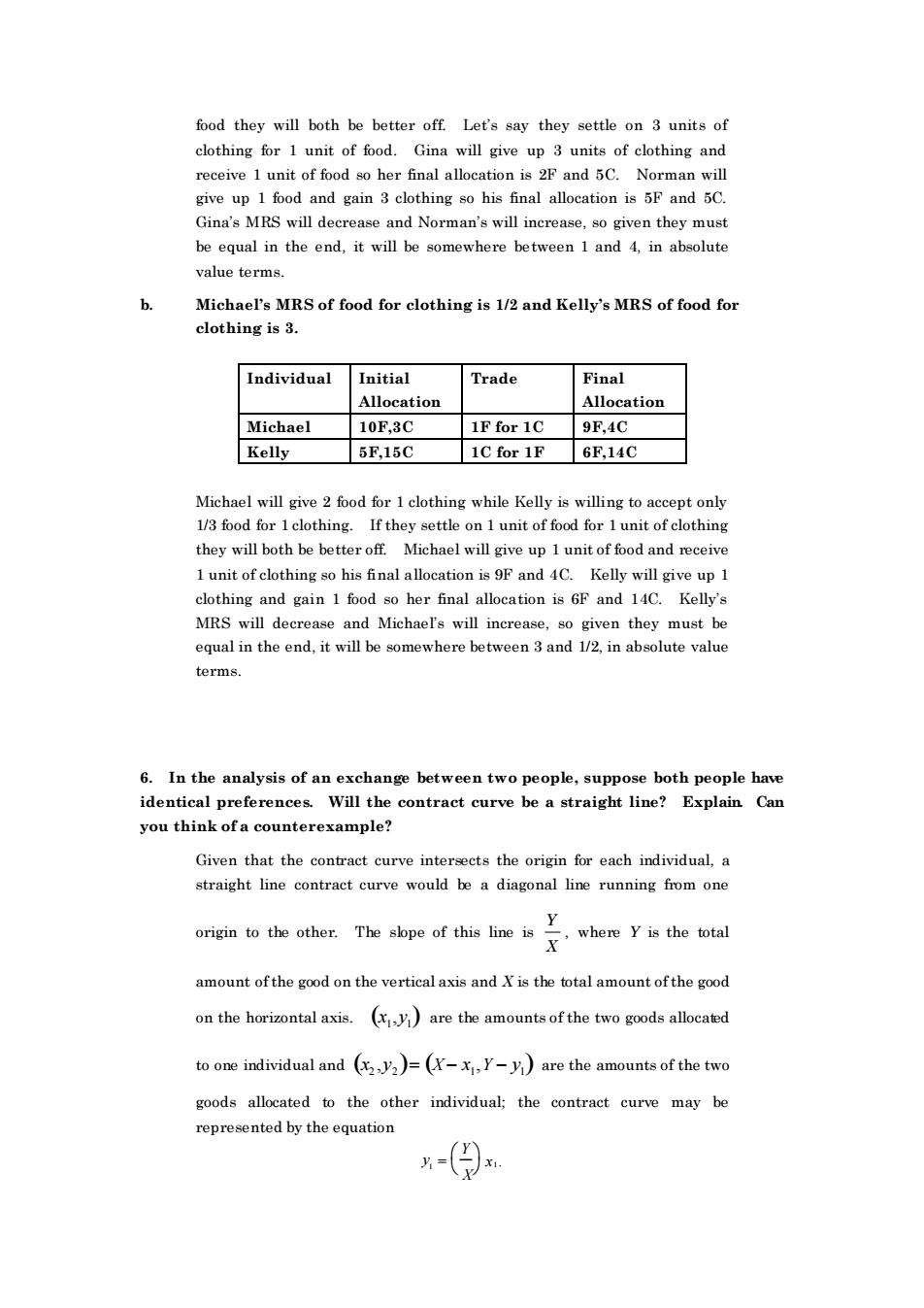正在加载图片...

food they will both be better off Let's say they settle on 3 units of clothingfor 1 unit of food.Gina will give s of clothing and receive unit of food so her final allocation is 2F and 5C.Norman wil give up 1 food and gain 3 clothing so his final allocation is 5F and 5C Gina's MRS will decrease and Norman's will increase.so given they must be equal in the end.it will be somewhere between 1 and 4.in absolute value terms Michael's MRS of food for clothing is 1/2 and Kelly's MRS of food for clothing is 3 Individual Initial Trade Final Allocation Allocation Michael 10F,3C 1F for 1C 9F,4C Kelly 5F,15C 1C for 1F 6F.14C Michael will give 2 food for 1 clothing while kelly is willing to accept onlv 1/3 food for 1clothing.If they settle on 1 unit of food for 1unit of clothing they will both be bet er off. Michael will give up1unit of fod and eceiv 1 unit of clothing so his final allocation is 9F and 4C.Kelly will give up I clothing and gain 1 food so her final allocation is 6F and 14C.Kelly's MRS will decrease and Michael's will increase,so given they must be egual in the end.it will be somewhere between 3 and 1/2 in absolute value terms. 6.In the analysis of an exchange between two people,suppose both people have identical preferences.Will the contract curve be a straight line?Explain Can you think of a counte rexample? Given that the contract curve intersects the origin for each individual,a straight line contract curve would be a diagonal line running from one origin to the other.The bpe of ths iewhen th tal amount of the good on the vertical axis andis the total amount ofthe good on the horizontal axis.)are the amounts of the two goods allocated to one individual and )=(Y-x,Y-y)are the amounts of the two goods allocated to the other individual;the contract curve may be represented by the equation -(food they will both be better off. Let’s say they settle on 3 units of clothing for 1 unit of food. Gina will give up 3 units of clothing and receive 1 unit of food so her final allocation is 2F and 5C. Norman will give up 1 food and gain 3 clothing so his final allocation is 5F and 5C. Gina’s MRS will decrease and Norman’s will increase, so given they must be equal in the end, it will be somewhere between 1 and 4, in absolute value terms. b. Michael’s MRS of food for clothing is 1/2 and Kelly’s MRS of food for clothing is 3. Individual Initial Allocation Trade Final Allocation Michael 10F,3C 1F for 1C 9F,4C Kelly 5F,15C 1C for 1F 6F,14C Michael will give 2 food for 1 clothing while Kelly is willing to accept only 1/3 food for 1 clothing. If they settle on 1 unit of food for 1 unit of clothing they will both be better off. Michael will give up 1 unit of food and receive 1 unit of clothing so his final allocation is 9F and 4C. Kelly will give up 1 clothing and gain 1 food so her final allocation is 6F and 14C. Kelly’s MRS will decrease and Michael’s will increase, so given they must be equal in the end, it will be somewhere between 3 and 1/2, in absolute value terms. 6. In the analysis of an exchange between two people, suppose both people have identical preferences. Will the contract curve be a straight line? Explain. Can you think of a counterexample? Given that the contract curve intersects the origin for each individual, a straight line contract curve would be a diagonal line running from one origin to the other. The slope of this line is Y X , where Y is the total amount of the good on the vertical axis and X is the total amount of the good on the horizontal axis. x1 ,y1 ( ) are the amounts of the two goods allocated to one individual and x2 ,y2 ( )= X − x1 ,Y − y1 ( ) are the amounts of the two goods allocated to the other individual; the contract curve may be represented by the equation 1 y = Y X x1